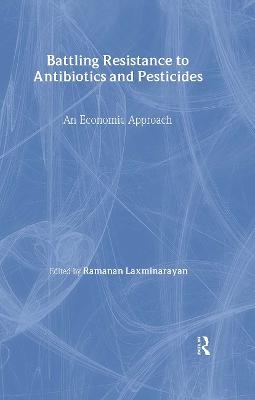
Battling Resistance to Antibiotics and Pesticides
Resources for the Future Press (RFF Press) (Verlag)
978-1-891853-51-7 (ISBN)
The increasing resistance of bacteria to antibiotics, and pests to pesticides, threatens to undo some of the most remarkable advances made in public health and agriculture during the past century. Though the potential consequences of increased antibiotic and pesticide resistance are far reaching, regulatory efforts to address the problem are at a very early stage. Battling Resistance to Antibiotics and Pesticides moves such discussions forward by presenting cutting edge research and the first comprehensive application of economic tools to analyze how antibiotics and pesticides should be used to maximize their value to society. Laxminarayan and his contributors explore lessons from past experiences with resistance, especially in agriculture. They consider what incentives would be ideal for the individuals who prescribe or apply antibiotics and pesticides, and what would be ideal for the firms engaged in developing and producing these products. The chapters in this groundbreaking book reflect the fact that efforts to combat resistance will require contributions from a broad range of scholars and professionals, representing a broad range of expertise. The analysis demonstrates that, for all these participants, an understanding of economic issues is an essential complement to knowledge of medical or biological factors. The book provides economists with an overview of relevant scientific issues, as well as a variety of analytical approaches to studying the economics of resistance. It offers policymakers detailed analyses of the multiple dimensions of resistance and discusses the future strategies to combat and manage resistance. For professionals in medicine, public health, and agriculture, the book translates the economic approaches into usable guidance for daily practice and decisionmaking.
Ramanan is a senior fellow at Resources for the Future in Washington, DC. His research includes the integration of epidemiological models of infectious disease transmission and the economic analysis of public health problems. He has worked with the World Health Organization on evaluating malaria treatment policy in Africa, and recently served on a National Academy of Science/Institute of Medicine Committee on the Economics of Anti-malarial Drugs. He teaches international health policy in the Johns Hopkins Bloomberg School of Public Health, and development economics at the Johns Hopkins University‘s Paul H. Nitze School of Advanced International Studies.
Contributors
About This Book
Introduction: On the Economics of Resistance
PART I. Issues of Optimal Management of Resistance
1. Dynamics of Antibiotic Use: Ecological versus Interventionist Strategies To Manage Resistance to Antibiotics
James E. Wilen and Siwa Msangi
2. Using Antibiotics When Resistance Is Renewable
Robert Rowthorn and Gardner M. Brown
3. Value of Treatment Heterogeneity for Infectious Diseases
Ramanan Laxminarayan and Martin L. Weitzman
Commentary: To Take or Not to Take the Antibiotic?
James N. Sanchirico
Commentary: Same Infection, Same Time, Same Antibiotic?
Stephen W. Salant
4. Pest Mobility, Market Share, and the Efficacy of Refuge Requirements for Resistance Management
Silvia Secchi and Bruce A. Babcock
Commentary: Need for Direct Collaboration between Economists and Biologists
Fred Gould
PART II. The Impact of Resistance
5. The Impact of Resistance on Antibiotic Demand in Patients with Ear Infection
David H. Howard and Kimberly J. Rask
Commentary: Measuring the Cost of Resistance
Ramanan Laxminarayan
6. What Can We Learn from the Economics of Pesticides? Impact Assessment of Genetically Modified Plants
Hermann Waibel, Jan C. Zadoks, and Gerd Fleischer
Commentary: The Role of Ecosystem Complexity in Genetically Modified Organisms
Karl Seeley
7. Elements of Economic Resistance Management Strategies Some Empirical Evidence from Case Studies in Germany
Gerd Fleischer and Hermann Waibel
Commentary: Can We Justify Resistance Management Strategies for Conventional Pesticides?
Fred Gould
8. Pesticide Resistance, the Precautionary Principle, and the Regulation of Bt Corn: Real and Rational Option Approaches to Decisionmaking
Beno t Morel, R. Scott Farrow, Felicia Wu, and Elizabeth A. Casman
9. Resistance Economics of Transgenic Crops under Uncertainty: A Real Option Approach
Justus Wesseler
Commentary: Economics of Transgenic Crops and Pesticide Resistance: An Epidemiological Perspective
Christopher A. Gilligan
PART III. The Behavior of Firms
10. An Economic Model of a Genetic Resistance Commons: Effects of Market Structure Applied to Biotechnology in Agriculture
Douglas Noonan
Commentary: Does the Monopolist Care about Resistance?
Carolyn Fischer
11. The Interaction of Dynamic Problems and Dynamic Policies: Some Economics of Biotechnology
Timo Goeschl and Timothy Swanson
12. Industrial Organization and Institutional Considerations in Agricultural Pest Resistance Management
Jennifer Alix and David Zilberman
Commentary: Strategic Issues in Agricultural Pest Management
R. David Simpson
Index
About the Editor
| Erscheint lt. Verlag | 26.12.2002 |
|---|---|
| Verlagsort | Washington |
| Sprache | englisch |
| Maße | 152 x 229 mm |
| Gewicht | 703 g |
| Themenwelt | Medizin / Pharmazie ► Pharmazie |
| Studium ► Querschnittsbereiche ► Prävention / Gesundheitsförderung | |
| Naturwissenschaften ► Biologie ► Mikrobiologie / Immunologie | |
| Technik | |
| Wirtschaft ► Allgemeines / Lexika | |
| Weitere Fachgebiete ► Land- / Forstwirtschaft / Fischerei | |
| ISBN-10 | 1-891853-51-1 / 1891853511 |
| ISBN-13 | 978-1-891853-51-7 / 9781891853517 |
| Zustand | Neuware |
| Haben Sie eine Frage zum Produkt? |
aus dem Bereich


